热门问题
时间线
聊天
视角
布里頓-諾曼BN-2島民飛機
来自维基百科,自由的百科全书
Remove ads
布里頓-諾曼 BN-2 島民(英文:Britten-Norman BN-2 Islander)是英國的輕型通用飛機與支線客機。由英國布里頓-諾曼公司設計製造。目前750架在用。全世界超過30個國家的軍隊或執法機構使用該型號飛機。
已隱藏部分未翻譯內容,歡迎參與翻譯。
開發
起源
1953年, Britten-Norman was formed for the purpose of converting and operating agricultural aircraft, amongst other vehicles such as the Cushioncraft hovercraft.[3][4] In 1963, the firm initiated development work upon what would become the Islander, having sensed a demand for a single and inexpensive twin-piston engine aircraft.[5] The founders, John Britten[6] and Desmond Norman, had observed the rapid growth of the commuter airline sector, and concluded that capacity was of a higher value to these operators than either range or cruising speed, thus the Islander emphasized payload over either of these attributes.[4]
Through the use of low wing- and span-loading to generate greater effectiveness than conventional counterparts, the Islander could lift considerably heavier payloads than the typical aircraft in its power, weight or cost classes.[7] To reduce manufacturing costs, both the wings and tail surfaces maintain a constant chord and thickness, while the ribs within the aircraft's wing are all identical; both rivets and external fishplate joints are used for the same purpose.[8] The type was originally intended to use a fabric-and-steel design. A light alloy monocoque approach was adopted instead.[5] The structure is designed to give rise to and experience low levels of stress, and has an infinite fatigue life without testing.[8]
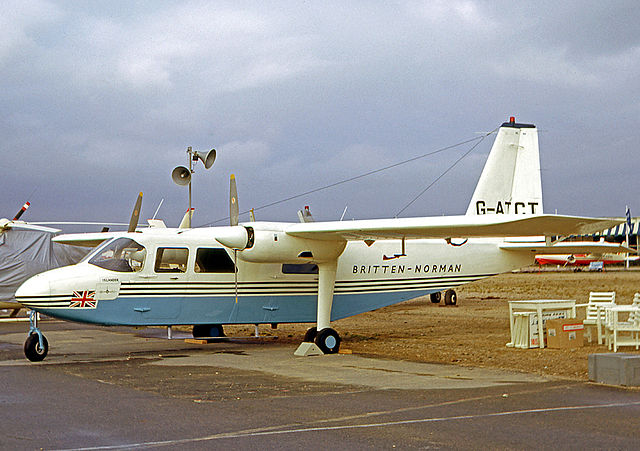
在1965年6月13日,the first prototype BN-2 Islander conducted its maiden flight, powered by a pair of Rolls-Royce/Continental IO-360B piston engines; only four days later, the prototype appeared at the Paris Air Show.[5][9] The IO-360B engines were later replaced by more powerful Lycoming O-540-E engines, which were located further outboard on the wings, for superior single-engine climb performance.[5] On 20 August 1966, a second BN-2 prototype performed its first flight. These prototype aircraft, while resembling subsequent production models for the most part, were outfitted with different, less powerful engines.[10] On 24 April 1967, the first production Islander performed its first flight; UK type certification was received in August 1967, US authorities also certified the type in December 1967.[5]
Initial production of the Islander started at the Britten-Norman factory at Bembridge on the Isle of Wight; however, within a few years the company found that it could not produce the aircraft at a sufficient rate to keep up with the customer demand.[3][11] To expand production, a contract was placed with Intreprinderea de Reparatii Material Aeronautic (IRMA) of Romania, initially to assemble kit-form aircraft, which were then sent to the UK for completion. In August 1969, the first Romanian-assembled Islander performed its first flight.[5] IRMA proved successful at economically producing the aircraft, producing roughly 30-40 aircraft per year at times, and eventually became the primary manufacturing site for the Islander.[3][5] In 1977, IRMA received a contract for the production of a further 100 Islanders; from that point on, the firm produced all subsequent Islander aircraft.[5][12] More than 500 of the type were manufactured in Romania.[13]
1970年,a military version of the Islander, marketed as the Defender, conducted its first flight. Modifications included the addition of underwing hardpoints for armaments/equipment, and the main cabin area being fitted out for light troop transport and support aircraft duties.[5] The Defender capitalised on the aircraft's rugged structure, making it suitable for long-term operations in developing countries. Purchases from police and military customers have typically been for use in surveillance and counter-terrorism operations. The Maritime Defender is another military version of the Islander, intended for search and rescue, coastal patrol and fishery protection.
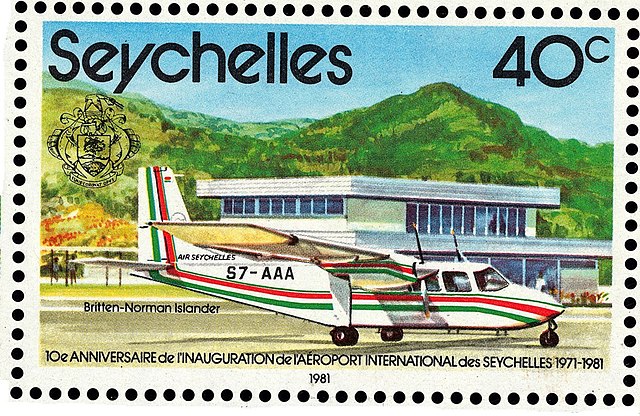
Further development
Despite the relative success of the Islander, Britten-Norman experienced wider financial difficulties during the late 1960s, ultimately resulting in the company entering receivership in October 1971.[5] In August 1972, Britten-Norman was purchased by the Fairey Aviation Group, forming the Fairey Britten-Norman company; shortly thereafter, the majority of manufacturing activity for both the Islander and Trislander was transferred to its Avions Fairey factory in Gosselies, Belgium. Completed aircraft were flown to Bembridge for final customer preparation prior to delivery.[3][14][15]
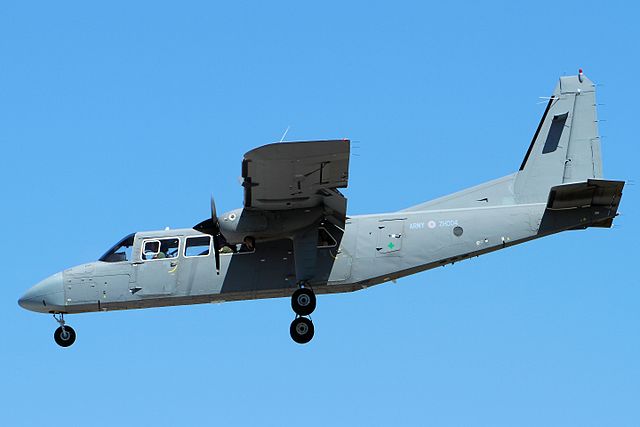
Fairey Aviation set about the development of a more powerful model, the Turbo Islander, equipped with a pair of Lycoming LTP101 turboprop engines. However, testing revealed that the LTP101 engines were too powerful for the aircraft; thus, following a period of re-designing, the project evolved into the Turbine Islander (BN-2T), equipped with a pair of Allison 250 turboprop engines instead.[3] However, Fairey itself encountered financial difficulty, resulting in the Fairey Britten-Norman company entering receivership and the firm's acquisition by Oerlikon Buerle of Switzerland, leading to the formation of Pilatus Britten-Norman, at which point some production activity was transferred back to Bembridge.[3][5]
Another development was a turbo-normalizing system with RaJay turbocharger for the -2, -3, -6, -8, and -9 models allowing full power up to 14,000 feet with attendant increase in true airspeed and takeoff and climb performance. Presently Talco in Texas holds the STC.
In 1969, an improved version, the BN-2A Islander, conducted its maiden flight. It incorporated aerodynamic and flight equipment improvements, such as lower-drag engine cowlings and undercarriage, an improved interior, and an expanded rear baggage area with external access.[5] In 1970, to improve hot-and-high performance, more powerful Lycoming O-540-K1-B5 engines were made available, alongside optional tiptanks and an elongated nose to house baggage.[5]

In 1977, a single standard BN-2 was re-engined with Dowty Rotol ducted fans. The ducted fan produced less noise than conventional propeller propulsion. Some structural strengthening of the main wing spar at the root was required due to the extra weight.[16] This aircraft was subject to 18 months of flying trials to test the suitability of the ducted fan as a means of reducing aircraft noise; these tests reportedly demonstrated a 20 decibel noise reduction as well as increased thrust and reduced pollution.[5][17]
In 1978, a further improved version, the BN-2B Islander II, was produced as a result of a product improvement program. The BN-2B model involved several changes, including a redesigned cockpit and a reduction in cabin noise levels.[5] In 1980, it was decided to make available turboprop engines for the type, adopting twin Allison 250-B17C engines; when the latter are installed, the aircraft is designated the BN-2T Turbine Islander. The first such BN-2T entered service in 1981.[5]
In February 1999, the acquisition of Romaero, the Romanian manufacturer of the Islander, by Britten-Norman Group was announced.[18][19] By May 2006, a greater sales emphasis was being placed upon the Defender over the Islander.[20] In December 2006, aerospace publication Flight International observed that: "The only civil aircraft that remains in production in the UK is the tiny Britten-Norman Islander".[21] In May 2010, Britten-Norman announced that manufacturing of the Islander would be relocated from Romania to a new site in the UK, due to the rising costs of production in Romania.[22]
Electric Project Fresson
Supported by Britten-Norman, Cranfield Aerospace wants to develop an electric propulsion system for the over 700 Islanders currently operated.[23]
Trislander
In 1968, the original second Islander prototype was re-used for a further development programme, being modified into a stretched aircraft with greater capacity, referred to as the Super Islander. However, the Super Islander programme was aborted without proceeding to certification.[5] The prototype later received further design changes to produce the three-engined version, the BN-2A Mk III Trislander.[3] This aircraft has a stretched fuselage, modified landing gear and a third engine, which is mounted on the tail.[5] On 11 September 1970, the Trislander prototype conducted its maiden flight, appearing at the 1970 Farnborough Air Show the same day.[5]
設計

The Britten-Norman BN-2 Islander is a high-wing cantilever monoplane with a rectangular fuselage and two wing-mounted engines; early aircraft were equipped with a pair of piston engines while later production models may be alternatively fitted with turboprop engines in their place.[5][10][24] The rectangular cross section fuselage, which is furnished with a conventional tail unit and fixed tricycle landing gear, typically accommodates a single pilot and up to nine passengers in a commuter configuration, each row being accessed by its own door; the cabin can be rapidly reconfigured, allowing for a single aircraft to undertake a diverse range of tasks within a minimal period of time.[10][25] Often referring to the type as "The world's most versatile aircraft",[24] Britten-Norman promotes the Islander's low direct operating costs, minimal maintenance, and its stability in flight as major attributes of the aircraft.[25]
The original Islander was designed with an emphasis upon providing ease of access within the short haul sector to remote locations as a safe, efficient, and profitable transport aircraft.[24] It has been regularly used by such operators, including the frequent use of unprepared rough airstrips and from challenging terrain; the Islander being capable of short takeoff and landing (STOL) operations.[24] The low load height and wide side doors provide for easy access for passenger and cargo operations, while the aircraft's ability to maintain a high takeoff frequency has led to the type's use for parachuting.[24] For operating within noise-sensitive environments, silencers can be equipped on both the aircraft's engine and propellers.[26]
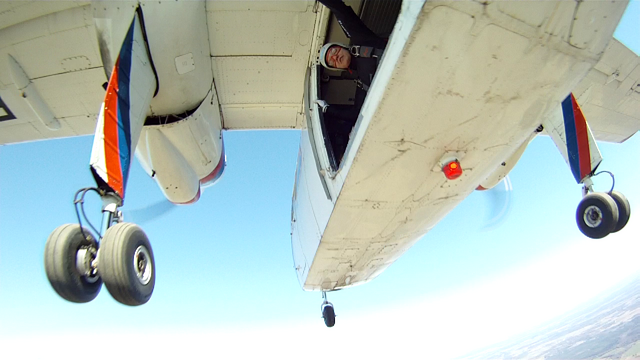
Designed as a small and inexpensive commuter/utility aircraft, various cabin configurations and equipment loadouts are available to suit a wide variety of different purposes, including charter flights, scheduled flights, agricultural uses, aerial firefighting, air freight VIP/executive transport, aerial surveillance, air ambulance, paradropping, and law enforcement.[5][24] The design programme can be entirely personalized, allowing each customer to be involved in every area of the aircraft's manufacture to mold it to their preferences.[25] Later versions of the Islander offer various options, including enlarged bay doors, 3-bladed scimitar propellers, low drag fairings, modern interior, ergonomic leather seating, in-flight entertainment systems, and alternative seat arrangements; underwing hardpoints can also be installed for carrying pod, spray booms and other external stores.[24][25]
使用歷史
Immediately following commercial availability, US distributor Jonas Aircraft ordered 30 Islanders, and placed orders for another 112 aircraft within a year.[5][8] When equipped with four 54-gallon fuel tanks, the Islander was able to ferry itself across the transatlantic route, via Gander International Airport, Newfoundland, for US deliveries.[5] The Islander's long-range capabilities were highlighted when the type won the 1969 London-Sydney air race.[5]
In 1974, sales of the Islander surpassed the 548-order record for British multi-engine commercial aircraft.[5] In 1982, another production milestone was reached with the delivery of the 1,000th Islander.[5] From the 1980s onwards, sales noticeably declined; according to Britten-Norman Chief Executive William Hynett, this was due to the global market having become saturated by the type and there being only a low civil demand for additional aircraft, in part due to the longevity of in-service Islanders.[20] As of 2016, Britten-Norman claim that the Islander is in daily service with roughly 500 operators in more than 120 countries.[24]
在1976年至2006年之間, 蘇格蘭航空 Loganair 運營了 a number of Islanders as air ambulances, covering areas such as the island communities in the Hebrides.[27] The Islander services Loganair's Westray to Papa Westray flight, the shortest scheduled flight in the world at 1.7 mi(2.7 km); the scheduled flight time including taxiing is two minutes.[28][29][30]
Several commuter airlines and general aviation charter operators in the U.S. also flew the Islander including Stol Air Commuter in scheduled passenger service in northern California from their San Francisco International Airport (SFO) hub and Channel Islands Aviation in southern California which used the aircraft for the flights to Channel Islands National Park.[31][32] Another U.S. commuter airline operator was Wings Airways which operated high frequency shuttle service into the Philadelphia International Airport (PHL).[33]
By October 2019, 800 Islanders were in service including around 600 used for short flights.[34]
型號
來源:[35]
- BN-2
- Prototype first flown in 1966 with two 260 hp Lycoming O-540-E4B5 piston engines.
- BN-2A
- Production version with minor modification from prototype and increased takeoff weight.
- BN-2A-2
- A BN-2A with modified flaps, and two 300 hp Lycoming IO-540-K1B5 (fuel injected) engines.
- BN-2A-3
- A BN-2A-2 with increased wingspan and fitted with extra wingtip fuel tanks.
- BN-2A-6
- A BN-2A with wing leading edge modifications and two 260 hp Lycoming O-540-E4C5 engine.
- BN-2A-7
- A BN-2A-6 with increased wingspan and fuel capacity.
- BN-2A-8
- BN-2A-6 的下垂翼版本。
- BN-2A-9
- BN-2A-7 的下垂翼版本。
- BN-2A-10
- A BN-2A-8 with increased takeoff weight and 270 hp Lycoming TIO-540-H1A (turbo-charged, fuel injected) engines.
- BN-2A-20
- A BN-2A-2 with increased takeoff weight and minor improvements.
- BN-2A-21
- 相比於BN-2A-3,增加了起飛時的載重量。
- BN-2A-23
- ABN-2A-21 的鼻錐延長版本。
- BN-2A-24
- BN-2A-26 的鼻錐延長版本。
- BN-2A-25
- A BN-2A-27 的鼻錐延長版本。
- BN-2A-26
- 相比於BN-2A-8,增加了起飛時的載重量。
- BN-2A-27
- 相比於BN-2A-9,增加了起飛時的載重量。
- BN-2A-30
- A BN-2A-20 fitted with floats. Twin floats were attached to the undercarriage legs and incorporated retractable landing gear.
- BN-2A-41
- Turbo Islander with lengthened nose, droop flaps and two Lycoming LTP-101 turboprops, first flown in 1977.
- Britten-Norman BN-2B Defender
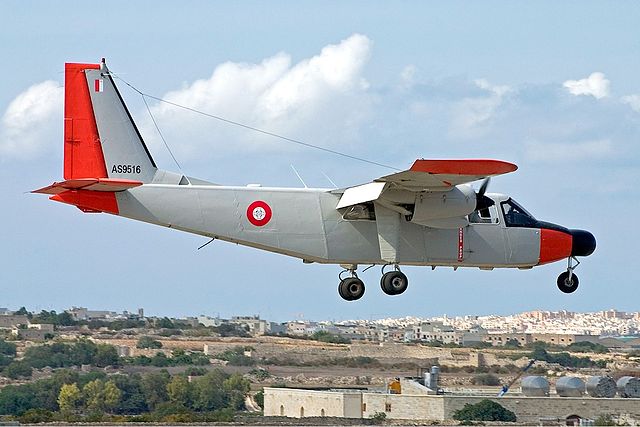
- Defender military variant with 300 hp IO-540-K1B5 engines and underwing hard points and military modifications.
- BN-2B-20
- A BN-2A-20 with improved soundproofing and increased landing weight and other minor modifications.
- BN-2B-21
- A BN-2A-21 with Model B improvements.
- BN-2B-26
- A BN-2A-26 with Model B improvements.
- BN-2B-27
- A BN-2A-27 with Model B improvements.
- BN-2T
- Turbine Islander based on BN-2A-26 with two 320 shp Allison 250-B17C turboprops. Seating for up to 9 passengers.

- Islander AL1
- Variant of the BN-2T for communications and reconnaissance duties with the British Army; seven built. Used for aerial reconnaissance and photography in Northern Ireland during Operation Banner by No. 1 Flight, Army Air Corps based at Aldergrove.[36] Redesignated Islander R1 in 2019 after being transferred to the Royal Air Force.[37]
- Islander CC2 and CC2A
- Variant of the BN-2T for the Royal Air Force; three operated.[38][39][40] These aircraft were retired from the RAF in 2017.[41]
- Maritime-Defender
- Armed maritime reconnaissance and patrol aircraft.
- BN-2A-III Trislander
- Three-engined Trislander, a stretched BN-2A with 18 seats and three 260 hp Lycoming O-540-E4C5 piston engines.
Remove ads
用戶
- 伯利茲國防軍[42]
- 博茨瓦納空軍[43]
- 中非共和國空軍[44]
- 丹麥國土安全部隊
- 剛果民主共和國空軍
- 岡比亞國防軍
- 加納空軍[47]
- 圭亞那國防軍
- 印度尼西亞陸軍[48]
- 皇家約旦空軍
- 馬達加斯加人民武裝力量
- 馬里空軍[51]
- 馬拉維國防軍
- 馬耳他空軍[51]
- 毛里塔尼亞國防軍[51]
- 毛里裘斯國防軍
- 墨西哥空軍
- 尼泊爾陸軍[52]
- 尼泊爾陸軍航空兵
- 荷蘭國家警察
- 阿曼皇家空軍
- 阿曼皇家警察
- 巴基斯坦海軍
- 巴基斯坦海軍航空兵
- 巴基斯坦海岸警衛隊
- 秘魯國家警察
- 塞內加爾空軍
- 阿聯酋空軍
- 委內瑞拉陸軍
- 委內瑞拉國民衛隊
- 扎伊爾空軍
- 比利時陸軍
- 比利時憲兵
- 西斯凱國防軍
- 海地武裝力量
- 馬拉維警察部隊
- 菲律賓空軍 - 許可製造
- 索馬里空軍
- 阿布杜拜國防軍空軍
- Carib Aviation
- LIAT
- Cape Air Transport
- Golden Eagle Airlines
- Airlines of Tasmania
- Lady Elliot Island Eco-Resort (Seair Pacific)
- Maya Island Air
- Gulf Aviation
- Aero Services
- Tropical Air Services
- Aero Star
- VOTEC
- Air BVI- 前用戶
- Air Montmagny(2)
- Alair MHA Enterprises (1)
- Gillam Air Services (1) - 前用戶
- Gold Belt Air Transport - 前用戶
- Great River Air (2)[63]
- Maritime Air Charter- 前用戶
- Northstar Air Tours (1)[64]
- Sable Aviation(1)
- Sander Geophysics (2)[65]
- South Nahanni Airways (1)
- Strait Air - 前用戶[66]
- Top of the World Flying Services - 前用戶
- Tsayta Aviation (1)[67]
- Villers Air Services (1) [68]
- Wagner Aviation - 前用戶
- Archipiélagos Aviación operates the two Islanders in Chile and the former South Pacific Korp aircraft [69]
- South Pacific Korp
- TAVINA
- Falck Air- 擁有3架島民:BN-2A-9 (OY-DZV), BN-2A-20 (OY-RPZ),BN-2B-26 (OY-CFV)
- Emetebe Airlines Galapagos
- Avies Ltd.
- Skydive Estonia
- Air Fiji
- Northern Air (Fiji
- Pacific Island Air
- 太平洋太陽航空
- AEROSOTRAVIA
- Airawak
- Air Caledonie
- St Barth Commuter
- Air Hamburg
- Bremerhaven Airline
- FLN Frisia Luftverkehr
- Helgoland Airlines
- Holiday Express
- LFH
- Luftfahrtgesellschaft Walter
- OLT
- Stuttgarter Flugdienst
- 漢堡航空
- Olympic Airways 前用戶
- Air Services Ltd
- Roraima Airways Ltd
- Trans Guyana Airways
- Aerolineas Sosa
- Flugfelag Vestmannaeyja
- Aer Arann Islands
- Garda Air Support Unit 愛爾蘭警察
- Ayit Aviation
- Aertirrena
- Trans Jamaican Airlines
- Air Dolphin
- 第一航空
- 旭伸航空 - 2008年10月1日停運
- 新中央航空
- 新日本航空
- 琉球空中通勤
- 海豚航空
- 珊瑚太陽航空 (2)
- 毛里裘斯海岸警衛隊[70]
- Aero Taxis de CV
- Aero Sudpacífico
- Aspiring Air Wanaka
- Fly My Sky 奧克蘭 (4)
- Great Barrier Airlines 奧克蘭 (2)
- Island Air Charters前用戶
- Mount Cook Airline前用戶
- Real Journeys Queenstown
- Stewart Island Flights Invercargill
- Wings over Whales Kaikoura
- Aero Taxi Intl
- Air Panama
- ANSA
- AVIATUR
- Aviones de Panama S.A.
- PARSA
- TRANSPASA
- Mid-Sea Express
- Pacificair
- ATA-Aerocondor
- Oceanair-Transportes Aéreos Regionais - Azores Islands
- TAC-Transportes Aéreos Continentais
- TAT-Transportes Aéreos de Timor- 葡屬東帝汶
- Air Flamenco
- Vieques Air Link
- Regional Air Services
- SVG Air
- Nevis Express (1993-2003)
- Air Samoa
- 波利尼西亞航空
- Caricom Airways
- Gum Air
- RVL Aviation[72] - 前用戶
- 2Excel Aviation Ltd
- Air Alderney
- APEM Aviation - 前用戶
- Aurigny Air Services, (海峽群島) (1968 - c.1990)
- 藍色群島航空, (海峽群島)
- Channel Islands Air Search, (海峽群島)
- Cheshire Police - 前用戶
- 英國海岸警衛隊 前用戶
- 福克蘭群島政府航空服務
- 大曼徹斯特警察 前用戶
- Hampshire Police
- Hebridean Air Services[73]
- Highland Airways
- Isles of Scilly Skybus[74]
- 洛根航空[75]
- Marine Fisheries Agency
- Precision Terrain Surveys Ltd
- RVL Aviation 前用戶
- Skydive Headcorn
Gem Air LLC- Salmon, Idaho
- Aero International- Florida - 前用戶
- Air Bahia
- Air Carolina- Florence, South Carolina - 前用戶
- AmericAir[76] - Washington Dulles International Airport - 前用戶
- 美屬薩摩亞政府
- Boise Air Service- Boise, Idaho
- Cape Air[77]
- Channel Islands Aviation - Camarillo, California
- Commutaire International Airways - Florida - 前用戶
- Great Northern Air
- Griffing Flying Service - Port Clinton, Ohio
- Harbor Airlines - Oak Harbor, Washington State
- Homer Air - Alaska
- Iliamna Air Taxi - Alaska
- Inter Island Airways- 美屬薩摩亞
- Island Air Charters- Florida
- Island Air Service- Kodiak, Alaska
- Island Airways- Beaver Island, Michigan (4) - 在用
- LAB Flying Service- Juneau, Alaska
- McCall Aviation- McCall, Idaho
- Munz Northern Airlines - Nome, Alaska (12) - 前用戶
- New England Airlines- Westerly, Rhode Island - 在用
- Pelican Airways
- Princeton Airways - Princeton Airport, New Jersey - 前用戶
- Rediske Air- Alaska
- Salmon Air- Salmon, Idaho -前用戶
- San Juan Airlines- Friday Harbor, Washington State
- Servant Air- Kodiak, Alaska
- Slocum Airlines - Florida - 前用戶
- SouthCentral Air - 阿拉斯加 前用戶
- South Pacific Island Airways - Guam - 前用戶
- Stol Air Commuter- San Francisco, California - 前用戶
- Tropic Air Charters - Ft. Lauderdale, Florida
- Wheeler Airlines- 前用戶
- Williams Air - 前用戶
- Wings Airways- Blue Bell, Pennsylvania - 前用戶
- Transaven
- Proflight Zambia
- Zamfari Limited盧薩卡
Remove ads
事故
- 1996 Loganair Islander accident
- 2005 Loganair Islander accident
- 2005 L.A.B. Flying Service accident
- 2012年大鵬航空BN-2空難
- 委內瑞拉環空BN-2A-27墜毀事件 2013年
- 2016 Sunbird Aviation crash
技術性能 (BN-2A 島民)




參考資料:The Observer's Book of Aircraft, Britten-Norman,[24] Flying[1]
基本信息
- 機組:1 或 2
- 容量:最多 9名乘客
- 展弦比:7.39
性能
- Takeoff run: 215 m
- Fuel consumption: 90 l(24 US gal)/h at 133 kn(246 km/h), 80 l(21 US gal)/h at 119 kn(220 km/h).[78]
參見
相關開發
- Britten-Norman Trislander
- Britten-Norman Defender
類似型號
參考文獻
Wikiwand - on
Seamless Wikipedia browsing. On steroids.
Remove ads


